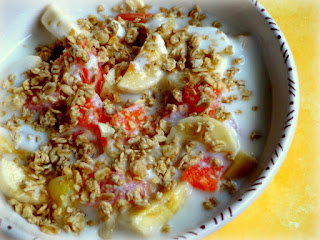I discovered Kefir last year and
quickly became addicted. Kefir is a thick and tangy fermented milk.
At first, it will remind you of drinkable yogurt. But nutrition-wise,
it is so much better: it packs high-quality protein and provides
plenty of calcium and probiotics too. Added bonus: it is low in
lactose so it's easy to digest. You can find Kefir in most grocery
stores now. I stick to the plain and low-fat kind, as the fruity
versions contain added sugar. You can also use it in place of buttermilk in pancakes and breads, or mix it in smoothies.
As always, the combination below is just one of many. Another favorite of mine it to use berries (I keep frozen ones in my freezer in the winter months) with vanilla-almond granola. No granola? No problem, any healthy cereal will do!
I love how this breakfast keeps
me feeling light, yet full and energized, all morning long!
Serves 1
- ¼ cup pineapple bits = 45 g de petits morceaux d'ananas
- ½ banana, sliced = ½ banane, coupée en morceaux
- ½ cara-cara orange, cut into chunks = ½ orange, coupée en morceaux
- ½ cup low-fat kefir = 120 ml de kefir
- 2 tablespoons mango passion granola cereal = 2 cuillères à soupe de granola (ou muesli) mangue-passion
Put fruit chunks into a shallow plate. Pour kefir over fruit and top with granola. Sit down and savor every bite!





